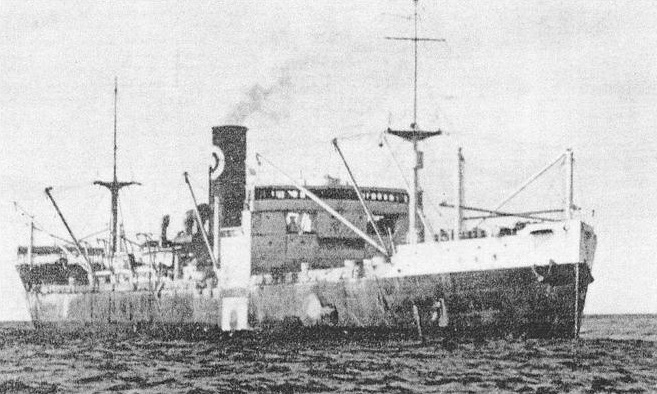KYURYOSEN!
 (KOSEI MARU, prewar)
(KOSEI MARU, prewar)
IJN KOSEI MARU:
Tabular Record of Movement
© 2018 Gilbert Casse, Berend van der Wal and Peter Cundall
E 1918:
Laid down by Workman, Clark & Co., Belfast as a War Standard G design ship, modified during construction. Scheduled name NEGANTI.
27 August 1918:
Launched and named NARENTA.
March 1919:
Completed as NARENTA for Royal Mail SP CO. with London as registered homeport. Built as a frozen meat carrier with refrigerated holds.
1932:
Sold to Royal Mail Lines Ltd as part of restructuring after Royal Mail SP Co encountered financial problems during the Great Depression (the collapse of the Royal Mail Group).
1939:
Sold to Nippon Suisan K.K. and renamed KOSEI MARU with Tokyo as registered homeport. Her GRT (gross registered tonnage) and NRT (net registered tonnage) respectively are 8,237-ton and 5, 956-ton [1] [2]
June 1939:
Reconstruction starts at Hitachi Zosen. Freezing equipment is extended. Thereafter, departs for North Pacific fishing grounds.
Autumn 1939:
Departs the Antarctic fishing grounds for Tokyo.
1940:
Arrives at Tokyo. Later that year leads four groups of eight fishing vessels and one trawler fish for turbot, cod, etc. Harvest amounts to 4,870.
1941:
Her GRT and NRT respectively are changed to 8,282-tons and 5,993-tons. [2]
1 September 1941:
Requisitioned by the IJN.
20 September 1941:
Registered as an auxiliary stores ship attached to the Kure Naval District under instruction No. 1093. Attached directly to the Combined Fleet as an auxiliary stores ship, (Otsu) category. Conversions for military duty starts at Osaka Iron works shipyard under Navy Captain Koyama Yoshiro (34) supervision. That same day, Navy Captain (Reserve) Hamada Takeshi is appointed supervisor. [3]
10 September 1941:
Reconstruction is completed.
17 November 1941:
Departs Kure for northern China waters.
26 November 1941:
Arrives at Shimonoseki.
1 January 1942:
At 0800, departs Takao, Formosa (now Kaoshiung, Taiwan) in convoy with KOAN, YODOGAWA, SENDAI, ASAYAMA and KIKU MARUs and KUREHA MARU No. 6 escorted by auxiliary gunboats MANYO, TAIKO, OKUYO and KAMITSU MARUs.
3 January 1942:
Arrives at Camiguin, Philippines. Departs later that day.
8 January 1942:
At 1030, arrives at Davao, Mindanao, Philippines. Provisions auxiliary gunboats MANYO and TAIKO MARUs with fresh food.
9 January 1942:
Davao. Provisions auxiliary gunboat KAMITSU MARU with food.
19 ~ 21 January 1942:
Davao. Provisions hospital ship ASAHI MARU with 6t fresh food.
21 January 1942:
Davao. Provisions auxiliary gunboat OKUYO MARU with fresh food.
31 January 1942:
Davao. Provisions auxiliary gunboat MANYO MARU with fresh food.
1 February 1942:
Davao. Provisions auxiliary gunboat OKUYO MARU with food.
5 February 1942:
Davao. Provisions auxiliary gunboat MANYO MARU with fresh food.
E 6 February 1942:
Departs Davao.
13 February 1942:
Arrives at Takao.
27 February 1942:
Departs Shimotsu for Macassar, Celebes (now Sulawesi), Dutch East Indies (now Indonesia).
24 March 1942:
Macassar. Provisions hospital ship ASAHI MARU with 5t ice for patients.
7 April 1942:
Macassar. Provisions auxiliary gunboat OKUYO MARU with fresh food.
E 8 April 1942:
Departs Macassar.
27 April 1942:
Arrives at Takao.
1 May 1942:
Attached to the Navy Department, Kure Naval District.
14 May 1942:
Released to her owners.
25 May 1942:
Removed from the Navy list under instruction No. 929.
22 September 1942:
Scheduled for fishing in Northern waters.
24 December 1942:
Her owners are changed to Teikoku Suisan Tosei K.K.
6 February 1943:
Departs Woosung (Wusong), southern China for Amoy (now Xiamen), southern China and Hong Kong.
8 March 1943:
Requisitioned again by the Navy as a general transport (Ippan Choyosen) attached to the Kure Naval District.
14 March 1943:
Departs Kure.
15 March 1943:
Arrives at Shimonoseki.
16 ~ 20 March 1943:
Loads frozen fresh food products, private goods and embarks two passengers.
21 March 1943:
Departs Shimonoseki.
23 March 1943:
Arrives at Kure. Loads fresh food products, canteen goods, stored grain products, weapons and 57 mail bags. Embarks 51 passengers and disembarks two passengers.
29 March 1943:
Departs Kure for Truk (now Chuuk), Central Carolines.
7 April 1943:
About 259 nautical miles NW Truk. LtCdr John A. Scotts (USNA '28) USS TUNNY (SS-282) attacks with a spread of two torpedoes. About 2255, two hits are obtained starboard aft at 08-40N, 147-00E. Four crewmen are KIA. The transport returns fire with deck gun. Ship is flooded and send message for assistance. She is later taken in tow by light cruiser NAGARA.
9 April 1943:
About 286 nautical miles NW Truk. Sinks at 08-53N, 146-42E.
31 May 1943:
Removed from the Navy general list.
Authors' Notes:
[1] Numerous ships bore this name like auxiliary transports (2,205 GRT 24) and (3,551 GRT 37), auxiliary collier/oiler (6,667 GRT 33), auxiliary small minelayer (1,026 GRT 15), IJA transports No. 889 (1,943 GRT 43) and No. 1031 (865 GRT 40), Okada Shosen cargo ship (3,262 GRT 19) and other smaller vessels.
[2] NRT is a ship's cargo volume capacity expressed in "register tons", one of which equals to a volume of 100 cubic feet (2.83 m3). It is calculated by subtracting non-revenue-earning spaces i.e. spaces not available for carrying cargo, for example engine rooms, fuel tanks and crew quarters, from the ship's gross register tonnage (GRT). Net register tonnage (NRT) is not a measure of the weight of the ship or its cargo, and should not be confused with terms such as deadweight tonnage or displacement.
[3] There were two categories of Kyuryosen. (Ko) category with an IJN Captain as supervisor aboard and (Otsu) category without.
Thanks go to Gengoro S. Toda of Japan.
- Berend van der Wal, Gilbert Casse and Peter Cundall.
Back to the Storeships Page





